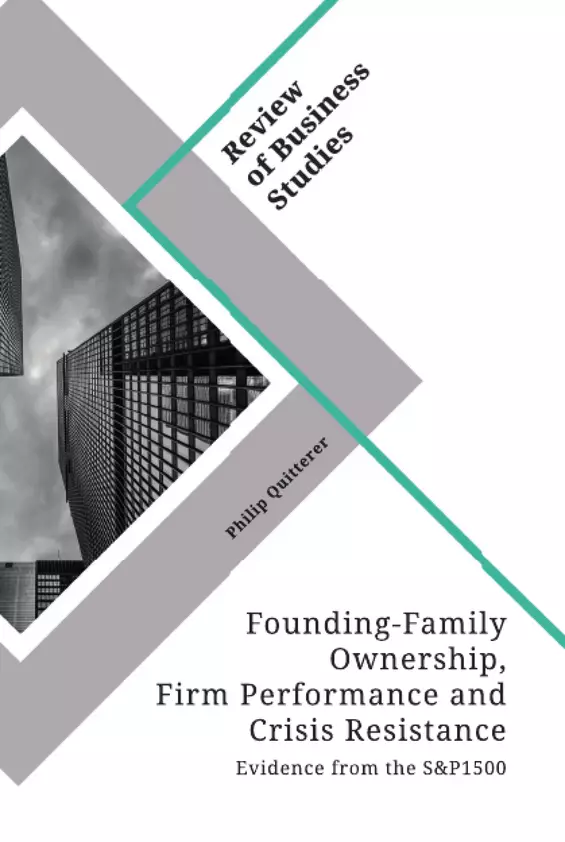To further complete the currently fragmented findings of family firm research, this empirical thesis analyses the performance of large founding-family firms listed in the USA. Thus, this research builds up upon the studies of Anderson and Reeb (2003), Cannella et al. (2015), Miller et al. (2007; 2011), and Villalonga and Amit (2006). For the analysis, a random sample of S&P1500 firms in the period 1996 – 2018 was generated. To obtain information on family firm variables such as ownership and managerial involvement, a manual research was conducted for all 300 firms in the sample using annual reports and proxy statements. The impact of several aspects of founding-family involvement was analysed in a panel data analysis that employed the performance measures Tobin’s Q and Return on Assets as dependent variables. Controlling for industry and firm characteristics, the results did not back up the postulated hypotheses. The findings could not support an eventual outperformance by founding-family firms and challenged the results of past studies through contrary findings on the influence of firm founders and their descendants. The results of the analysis of Tobin’s Q and Return on Assets differ significantly and raise the question to which extent these differing results can be attributed to the stock market’s view on founding-family firms.
Inhaltsverzeichnis (Table of Contents)
- Introduction
- What constitutes a founding-family firm?
- Theory and hypotheses
- Methodology
- Findings
- Discussion and conclusion
Zielsetzung und Themenschwerpunkte (Objectives and Key Themes)
This empirical thesis aims to shed light on the performance of large founding-family firms listed in the USA, specifically focusing on the impact of family involvement on firm performance. It builds upon previous research to contribute to the existing knowledge of family firms and their performance.
- Performance of founding-family firms
- Impact of family involvement on firm performance
- Comparison of family firm performance with non-family firms
- Agency conflicts and their mitigation in family firms
- Long-term investment horizon and its influence on family firm performance
Zusammenfassung der Kapitel (Chapter Summaries)
- Introduction: This chapter provides a brief overview of existing research on family firms and their performance, highlighting the varying results and inconsistencies found in previous studies. It introduces the research question of this thesis, which examines the performance of large founding-family firms in the USA.
- What constitutes a founding-family firm?: This chapter discusses the different definitions of family firms used in past research, highlighting the varying levels of family involvement and ownership thresholds. It explains the specific definition of family firms employed in this thesis, drawing upon previous studies such as Anderson and Reeb (2003), Cannella et al. (2015), Miller et al. (2007; 2011), and Villalonga and Amit (2006).
- Theory and hypotheses: This chapter presents the theoretical background and derives the hypotheses tested in this thesis. It focuses on the argument of agency conflict mitigation through the combination of ownership and control in family firms, as well as the potential for increased long-term value maximization and investment efficiency due to the family's long-term investment horizon.
- Methodology: This chapter details the methodology employed in the thesis, explaining the sample selection, data collection, and statistical analysis techniques used. It discusses the variables included in the analysis, including performance measures such as Tobin's Q and Return on Assets (ROA).
- Findings: This chapter presents the main findings of the empirical analysis, discussing the impact of family involvement on firm performance, measured by Tobin's Q and ROA. It analyses the influence of different constellations of family involvement, such as first and second-generation family firms, and lone founder firms.
Schlüsselwörter (Keywords)
The thesis focuses on the performance of large founding-family firms, exploring the impact of family involvement on various performance measures such as Tobin's Q and Return on Assets (ROA). Key themes include agency conflict, long-term value maximization, investment efficiency, and the role of family influence on firm performance. The research is rooted in the empirical analysis of a sample of S&P1500 firms, employing panel data analysis and industry-adjusted performance metrics.
- Citation du texte
- Philip Quitterer (Auteur), 2019, Founding-Family Ownership, Firm Performance and Crisis Resistance, Munich, GRIN Verlag, https://www.grin.com/document/984048



